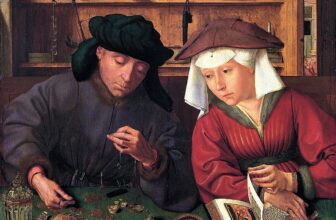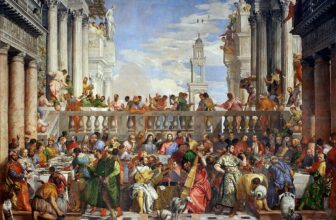
What is the Meaning of the Bacchus Painting
At first glance, The Triumph of Bacchus appears to be a traditional Bacchic scene, one filled with celebration and indulgence. However, Velázquez’s approach was unique. Instead of presenting a glorified, ethereal image of Bacchus, he grounded the composition in reality. Bacchus is depicted as a youthful, almost theatrical figure, crowned with ivy and draped in classical robes, but he is not distant or untouchable. He sits comfortably among a group of rough, working-class men who drink and laugh as they celebrate his presence.
This fusion of myth and reality suggests a deeper meaning, perhaps a reflection on the transient nature of pleasure or an acknowledgment of wine’s power to elevate and liberate the common man. Bacchus, the deity who provides revelry and escape, is presented as both divine and human, bridging the gap between the celestial and the everyday.
Additionally, the presence of shadowy figures in the background contributes to an air of mystery, hinting at the dual nature of intoxication, both its joyful freedom and its potential dangers. The realism of the peasants’ faces, with their rough textures and gleeful expressions, adds an earthy authenticity to the scene, reinforcing Velázquez’s signature style of capturing humanity in all its forms.
Who Painted The Triumph of Bacchus
One of the most magnificent Baroque paintings ever created, The Triumph of Bacchus, also known as Los Borrachos (The Drunks), was painted by the Spanish master Diego Velázquez in 1628-1629. Velázquez, who would go on to become the leading court painter for King Philip IV of Spain, was widely admired for his realistic style and ability to infuse everyday scenes with profound depth and character. This particular work was an early example of his genius, demonstrating his remarkable command of light, texture, and human expression.
Commissioned by Philip IV, The Triumph of Bacchus stands as an extraordinary blend of mythology and realism, showcasing Velázquez’s talent in merging divine themes with the common, everyday people of Spain. Unlike the idealized depictions of gods and mythical figures seen in Renaissance art, Velázquez presents Bacchus, the Roman god of wine, as a tangible, lifelike figure, interacting with a group of peasants who revel in drunken merriment.
What is the Triumph of Bacchus Myth?
The myth behind The Triumph of Bacchus dates back to ancient Roman and Greek mythology. Bacchus, also known as Dionysus in Greek mythology, was the god of wine, fertility, and revelry. His “triumph” refers to the processions he led across the world, spreading the art of winemaking and liberating people through the joy of his gift.
One of the most famous tales recounts Bacchus’s journey through India, where he rode in a grand chariot drawn by leopards or tigers, accompanied by a rowdy entourage of satyrs, maenads, and other divine followers. These processions symbolized the triumph of wine and ecstasy over rigidity and restraint. Bacchus was often portrayed as a deity who broke societal norms, allowing people, regardless of class or status, to partake in uninhibited celebrations.
Velázquez’s The Triumph of Bacchus takes inspiration from this myth but interprets it in a more grounded, human-centered way. Rather than an extravagant chariot scene, Bacchus is shown in a rustic setting, embracing the very people he seeks to liberate. The inclusion of commoners suggests that the “triumph” of Bacchus is not merely about divine conquest but about his ability to bring joy to ordinary people, offering them brief respite from their harsh realities.
Where is The Triumph of Bacchus Painting Today?
Today, The Triumph of Bacchus is housed in the Museo del Prado in Madrid, Spain. As one of Velázquez’s most celebrated early masterpieces, it is a significant part of the Prado’s extensive collection of Spanish Baroque art. Visitors to the museum can admire the intricate details, the masterful play of light and shadow, and the stunning realism that Velázquez imbued into his work.
The Prado Museum, renowned for its collection of European masterpieces, is home to some of the greatest works of Velázquez, including Las Meninas and The Surrender of Breda. The Triumph of Bacchus remains an essential piece for art enthusiasts and historians, providing a window into Velázquez’s early style and his ability to blend mythological themes with the rawness of real life.
The Triumph of Bacchus is more than just a depiction of revelry; it is a profound exploration of divinity, humanity, and the fleeting nature of pleasure. Diego Velázquez, with his unparalleled skill, transformed a classical myth into a scene that resonates with realism and authenticity. By placing Bacchus among ordinary men, he broke the traditional barriers between the celestial and the mundane, presenting a scene that speaks to the universal experience of joy and indulgence.
Whether one interprets it as a commentary on escapism, a celebration of life’s simple pleasures, or an homage to the power of art itself, The Triumph of Bacchus remains a timeless masterpiece. Housed in the Museo del Prado, it continues to captivate audiences, offering a glimpse into the extraordinary mind of Velázquez and the enduring allure of Bacchus’s mythical triumph.




